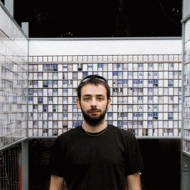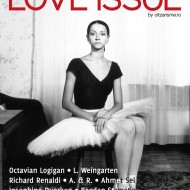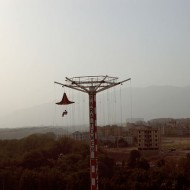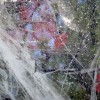Levi van Veluw is a young artist that works on self-portrait. But it does not simply photographs his face or body, he add on his skin and visage a lot of heterogeneous elements, building a complex sculpture and transforming his face in a miniature landscape. All the process is a self man work, and there is digital addition.
Fabiano Busdraghi: How did you start taking pictures? What is your history as a photographer?
Levi van Veluw: I was born in the Netherlands in a small town named Hoevelaken, 19-04-85.I graduated cum laude from Artez’ School of Arts in 2007. I started out mainly wanting to be a painter but during my time studying I started experimenting with other mediums such as video art and photography. The selfportaits started as a practical choice, but developed as a main concept in the last 3 years.
Fabiano Busdraghi: What is photography for you
Levi van Veluw: For me it’s just a medium. I use photography to registrate the sculptures on myself.
Fabiano Busdraghi: How the idea of building “landscape portraits” was born? Can you describe your work?
Levi van Veluw: I’s not just one idea. But one old fascination with cheap landscape painting. I hate all the symbolic they contain. The scenery is so predictible and boring. But in another way, I really like the simplicity of the traditional landscapes. It’s nice and ugly at the same time.
Fabiano Busdraghi: Describing your work you insist on the fact that it is a one man work. Can you explain in some details why this is so important to you?
Levi van Veluw: The work is created through several combinations of idea’s. I started experimenting with portraits a few years ago. After every photo, I analyze the work and discuss with myself what is good and what is not. Therefore it is not really a portrait, but more a series of experiments. Creating the work, is a one man process. It is very important that I make every decision while I am creating the work itself because the process is part of the work. The objects really exists on my head and not though the use of a computer.
Fabiano Busdraghi: This is another point on which you insists. Why this is so important? Is the final result or the proceeding that makes the art? What would be the difference in using a pc?
Levi van Veluw: In most cases it is my head that is the carrier of these transformations and combinations. The expressionless, and almost universal face, allows the viewer to project himself onto the work. Because the works have really existed and have not been digitally manipulated, each image contains a short history of a performance.
Fabiano Busdraghi: In one of your interview I read: “I tried to make my landscapes with as little symbolism as possible. So I kept the nice aspect of a landscape and removed all the kitsch, glamour and traditional aspects.” Can you develop this point explaining why you made this choice?
Levi van Veluw: I became more and more aware that all objects, materials, events are assigned a commonly held value, but that this valuation could just as easily be different. It was those elements that nobody had an opinion about that then became most interesting to me. Because they seem to contain little meaning to people, they are malleable and can easily have their perceptions about them altered.
Fabiano Busdraghi: In your photos you are always at the same time the photographer and the subject. Can you explain what is the meaning of this choice? Why you don’t use other peoples faces as a background for your landscapes?
Levi van Veluw: Repetition is a theme I find very interesting as you can use it for different ends. By for example using the same head and facial expression, the person slowly becomes of secondary importance to the form. The elements that remain constant lose their value and the elements that change, become the subject of the work. In this way I create a shift in the hierarchy of values.
Fabiano Busdraghi: The diffusion of your work is done by galleries, exhibitions, paper publications, etc, or is entrusted mainly to artistic circuits on Internet? What do you think about these initiatives?
Levi van Veluw: The combination of having a gallery, exhibitions, publications and the internet is really important. For instance, a gallery is important to present the work on artfairs and show and sell the work to artcollectors, museums etc. By having a gallery I have more time for making new work, ad that’s most important for me.
Fabiano Busdraghi: What are your favorite photographic and art sites? Do you read any photo e-zine, blog or online art magazine?
Levi van Veluw: Most times I read the art section of the dutch newsapers on the internet. And I like these blogs: http://pytr75.blogspot.com/ http://iheartphotograph.blogspot.com/
Fabiano Busdraghi: Do you have any photographic dream? Something you want to shoot and you can’t, some camera you dream to have, some place you want to go…
Levi van Veluw: At this moment I am really spoiled with all the succes. I have everything I want and do everything I want to do. Making new and better work will always stay my main ambition. Although I do have one majore ambition for the future, that’s setting up a new institute for arts.
Fabiano Busdraghi: Can you speak about one or more of your favorite photographer and tell us why you love his/their work?
Levi van Veluw: I like artist like, Jeff Wall and Erwin Wurm.
Fabiano Busdraghi: During the past you had been an assistant of Erwin Olaf. Can you describe your experience? How is working with a master of contemporary photography?
Levi van Veluw: Mainly working really hard for 6 months. I liked traveling to the US, France etc. I learned lot’s of things, but you also see things you want to do differently.



































That’s awesome.
You can also subscribe to this post comments RSS feed.